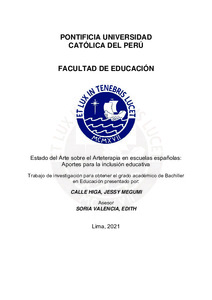Estado del Arte sobre el Arteterapia en escuelas españolas: Aportes para la inclusión educativa
Abstract
Este Estado del Arte presenta una investigación acerca de las contribuciones del
Arteterapia, al campo educativo, para el desarrollo de las habilidades sociales en niños
con TEA. El estudio se realiza con la finalidad de reflexionar sobre tres aportes
principales que ha brindado esta estrategia, durante los últimos cinco años, a la
educación española. Dichos aportes se relacionan con tres clasificaciones distintas de
habilidades sociales que los estudiantes inclusivos logran fortalecer a partir de la
implementación del Arteterapia en la escuela; aquellas son: la expresión y
comunicación no verbal, la utilización de canales de expresión oral y escrita, y la
flexibilidad de pensamiento y autorregulación emocional. La investigación se
encuentra clasificada dentro del tipo documental; por esta razón, se desarrolla a partir
del análisis de fuentes académicas publicadas, durante los últimos cinco años, en
universidades españolas interesadas en el estudio del Arteterapia educativa. De esta
manera, el presente trabajo se estructura en tres subtemas que permiten el desarrollo
y sustentación de los aportes, precisado anteriormente, del Arteterapia a la educación.
Seguidamente, se analizan diversos recursos y actividades implementadas para la
adquisición de las habilidades sociales vinculadas a cada aporte. De igual forma, las
reflexiones finales resaltan lo valiosa que resulta esta estrategia para establecer una
mejor comunicación entre docentes y estudiantes, pues ayuda a estos últimos a
expresarse con mayor fluidez. Asimismo, expresan la necesidad de realizar
investigaciones acerca de la implementación del Arteterapia en áreas curriculares
diversas, con el objetivo de lograr aprendizajes más significativos en todos los
estudiantes. This State of the Art presents research on the contributions of Art Therapy, to the
educational field, for the development of social skills in children with ASD. The study
was carried out with the aim of reflecting on three main contributions that this strategy
has provided, over the last five years, to Spanish education. These contributions relate
to three distinct classifications of social skills that inclusive students manage to
strengthen from the implementation of Art Therapy in school; those are: nonverbal
expression and communication, the use of channels of oral and written expression,
and the flexibility of thought and emotional self-regulation. The research is classified
within the documentary type; for this reason, it required the search and analysis of
academic sources published, during the last five years, in Spanish universities
interested in the study of educational art therapy. In this way, this work is structured in
three sub-themes that allow the development and support of the contributions,
previously specified, from Art Therapy to Education. Next, various resources and
activities implemented for the acquisition of the social skills linked to each contribution
are analyzed. The final reflections highlight how valuable this strategy is to establish
better communication between teachers and students, as it helps the latter to express
themselves more fluently. They also express the need for research on the
implementation of Art Therapy in diverse curricular areas, with the aim of achieving
more meaningful learning in all students.
Temas
Terapia de arte
Autismo infantil
Psicopedagogía infantil
Educación inclusiva
Autismo infantil
Psicopedagogía infantil
Educación inclusiva
Para optar el título de
Bachiller en Educación
Collections
The following license files are associated with this item:






